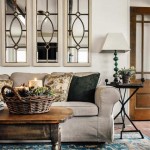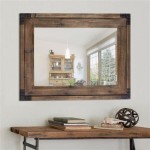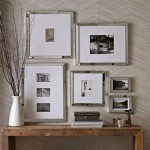Hanging a Heavy Mirror on a Brick Wall: A Comprehensive Guide
Securing a heavy mirror to a brick wall presents a unique set of challenges compared to hanging it on drywall or plaster. Brick, a durable yet porous material, requires specialized techniques and hardware to ensure the mirror remains safely and securely mounted. This article provides a comprehensive guide to properly hanging a heavy mirror on a brick wall, covering essential considerations, required materials, and step-by-step instructions.
Before commencing any installation, assessing the brick wall's condition is paramount. Are there any cracks, crumbling mortar, or evidence of water damage? Such issues can compromise the integrity of the brick and subsequently the stability of the mirror mount. Any identified problems should be addressed before proceeding. Furthermore, understanding the type of brick used is beneficial. Different brick compositions and densities can influence the choice of anchors and the drilling technique required.
The weight of the mirror is a critical factor in determining the appropriate hanging method and hardware. A lightweight mirror might be adequately supported by adhesive strips specifically designed for brick surfaces, but a heavier mirror necessitates a more robust anchoring system. Accurately weighing the mirror is crucial to selecting hardware with a sufficient weight-bearing capacity. Overestimating the mirror's weight is always preferable to underestimating it.
Key Point 1: Selecting the Right Hardware
Choosing the correct hardware is arguably the most important step in hanging a heavy mirror on a brick wall. The chosen anchors must be compatible with the type of brick and capable of supporting the mirror's weight, along with any potential additional stress. Several types of anchors are suitable for brick, each with its own advantages and disadvantages. Options include:
Sleeve Anchors: These anchors consist of a bolt, a sleeve, and a nut. As the bolt is tightened, the sleeve expands, gripping the inside of the drilled hole. Sleeve anchors offer high holding power and are suitable for heavy mirrors. They are commonly available in various lengths and diameters to accommodate different brick thicknesses and weight requirements. Selecting a sleeve anchor with a corrosion-resistant coating is advisable, especially in humid environments.
Wedge Anchors: Similar to sleeve anchors, wedge anchors provide a strong and reliable hold. They consist of a bolt, a clip, and a nut. When tightened, the clip wedges against the sides of the drilled hole, creating a firm grip. Wedge anchors are known for their strength and ability to resist pull-out forces. These anchors are best suited for solid brick walls, as they require a consistent, solid material to properly engage.
Tapcon Screws: Tapcon screws are specifically designed for use in concrete and masonry. They feature hardened threads that cut into the brick as they are installed. Tapcon screws offer a relatively easy installation process compared to sleeve or wedge anchors, as they do not require a separate anchor to be inserted into the hole. However, they may not provide the same level of holding power as other anchor types, particularly in softer or more porous brick. Pre-drilling a pilot hole of the correct size is essential for successful Tapcon screw installation.
Brick Clips: While not suitable for particularly heavy mirrors, brick clips offer a no-drill solution for lighter mirrors. These clips attach to the brick by gripping the edges of the brick itself. Their weight-bearing capacity is limited, and they are generally better suited for decorative items rather than substantial mirrors. Carefully assessing the mirror's weight and the clip's rated capacity is crucial before using brick clips.
Irrespective of the chosen anchor type, it is essential to consult the manufacturer's specifications for the anchor's weight rating and installation instructions. Always err on the side of caution and select an anchor with a higher weight rating than the mirror's actual weight. Furthermore, using multiple anchors, spaced appropriately, can distribute the weight and increase the overall stability of the mount.
Key Point 2: Proper Drilling Technique
Drilling into brick requires a specialized drill bit designed for masonry. Using a standard drill bit will likely damage the bit and fail to create a proper hole. Carbide-tipped drill bits are the most common and effective for drilling into brick. The size of the drill bit must precisely match the diameter specified by the anchor manufacturer for the chosen anchor type. Using the wrong size drill bit can result in either a too-loose or too-tight fit, compromising the anchor's holding power.
Before drilling, accurately mark the desired location for each anchor. Using a level is crucial to ensure the mirror will hang straight. A pencil or marker can be used to mark the spots directly on the brick. Consider using painter's tape to provide a cleaner surface for marking and to prevent chipping of the brick surface during drilling.
When drilling, apply consistent and even pressure. Avoid forcing the drill or attempting to drill too quickly. Let the drill bit do the work. A hammer drill, which provides both rotational and percussive action, is highly recommended for drilling into brick. The hammering action helps to break up the brick, making it easier to drill a clean and accurate hole. If a hammer drill is unavailable, a standard drill can be used, but the drilling process will be slower and more demanding.
During the drilling process, periodically remove the drill bit to clear debris from the hole. This will prevent the bit from overheating and becoming clogged. A vacuum cleaner can be used to remove the dust and debris from the hole before inserting the anchor. Clearing the hole ensures the anchor sits flush against the brick surface and provides optimal grip.
The depth of the drilled hole is another critical factor. The hole must be deep enough to accommodate the entire length of the anchor, as specified by the manufacturer. Using a depth gauge or marking the drill bit with tape can help ensure the correct drilling depth. Drilling too shallow a hole will prevent the anchor from fully engaging, while drilling too deep can weaken the surrounding brick.
Key Point 3: Safe Installation Practices
Safety should be paramount throughout the entire process of hanging a heavy mirror on a brick wall. Wearing appropriate safety gear is essential to protect against potential hazards. Safety glasses are necessary to shield the eyes from flying debris during drilling. A dust mask or respirator is recommended to prevent inhalation of brick dust, which can be harmful to the respiratory system. Gloves can protect the hands from abrasion and cuts.
Before drilling, ensure that there are no electrical wires or plumbing pipes running behind the brick wall at the drilling locations. Using a stud finder with metal detection capabilities can help identify potential hazards. If there is any uncertainty about the presence of utilities, consulting a qualified electrician or plumber is advisable.
When lifting and positioning the heavy mirror, enlisting the help of another person is strongly recommended. Attempting to lift and maneuver a heavy mirror alone can lead to back injuries or accidental dropping of the mirror. Coordinating movements and communicating clearly with the other person will ensure a safer and more controlled installation process.
After installing the anchors, test their stability by applying a moderate amount of pressure to each anchor point. Ensure that the anchors are securely seated and do not exhibit any signs of slippage or movement. If any instability is detected, re-evaluate the anchor type, drilling technique, or brick condition.
Finally, carefully hang the mirror onto the installed anchors. Ensure that the mirror is properly seated on the mounting hardware and that the weight is evenly distributed across all anchor points. Use a level to make any necessary adjustments to ensure the mirror is hanging perfectly straight.
Following these guidelines will allow for the safe and secure installation of a heavy mirror on a brick wall. Prior planning, careful material selection, and adherence to proper techniques are crucial for a successful outcome.

How To Hang A Heavy Mirror On Brick Fireplace Drill Into Dans Le Lakehouse

How To Hang A Heavy Mirror Securely Bob Vila

How To Stick Mirror On Brick Wall Bunnings Work Community

How To Hang A Large Wall Mirror Step By Tutorial

How To Hang A Heavy Mirror Onto Gyprock And Brick Wall

How To Hang A Heavy Mirror On Brick Wall Hanging Tips Easy Tutorial Homify

3 Simple Ways To Hang A Mirror On Wall Without Nails Wikihow

Quickest Way To Hang Mirror On Brick Wall

How To Hang A Large Or Heavy Mirror

How To Hang Something On Brick 12 Steps With Pictures Wikihow








